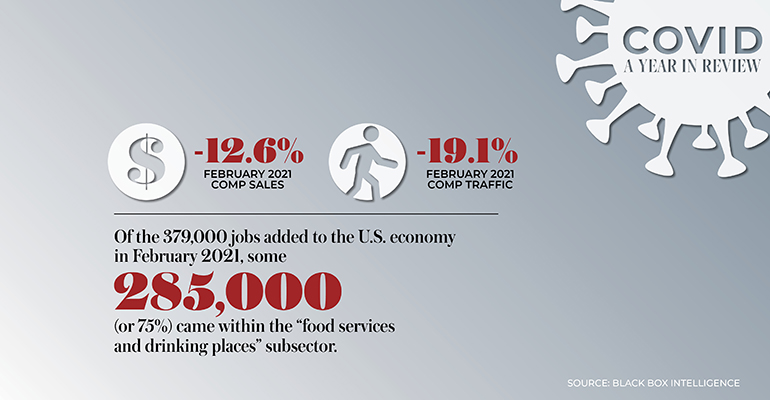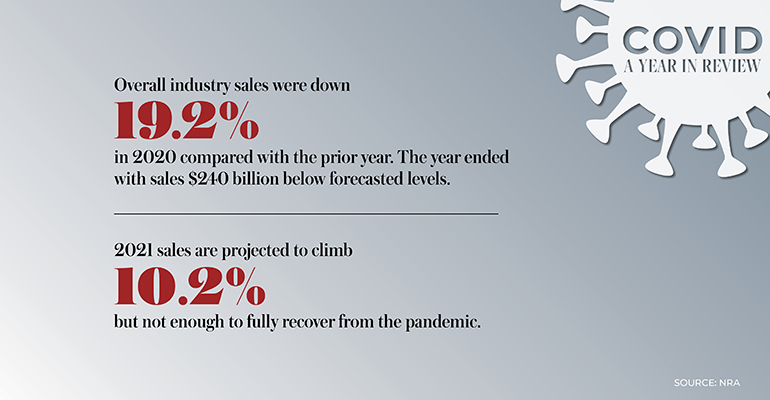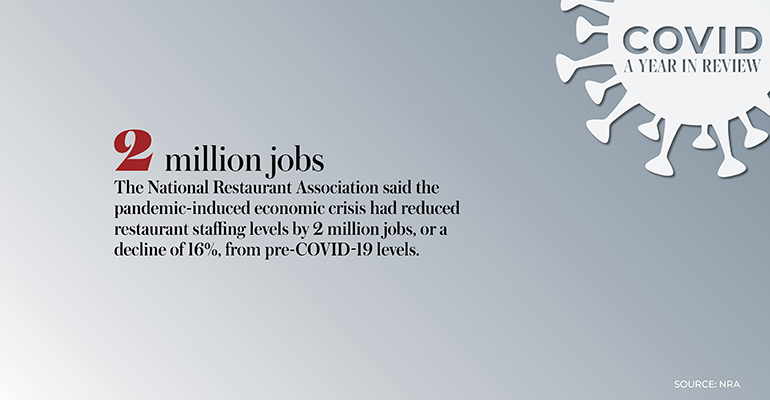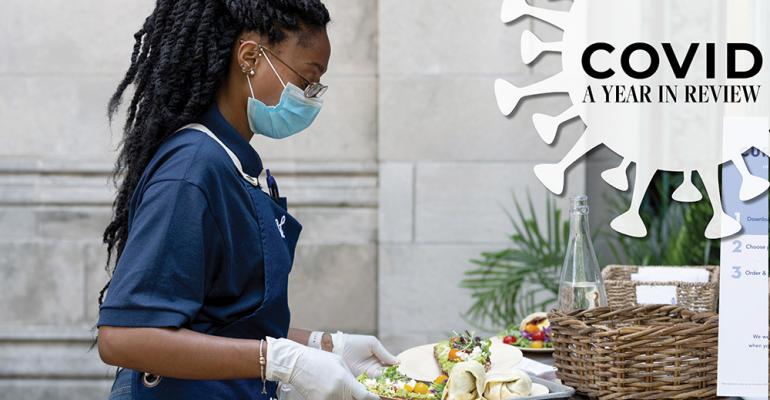Independent restaurants were especially hard-hit during the past year of COVID-19.
The global pandemic, which was declared by the World Health Organization on March 11, 2020, has — through a series of alerts, lockdowns and quarantines aimed at slowing the coronavirus’ spread — accelerated change, transformed hospitality and, sadly in some quarters, decimated the industry.
As many as 110,000 restaurants have closed since the pandemic was declared, according to the National Restaurant Association, and foodservice sales have fallen $255 billion in the year since.
“The main thing that I have learned is just how resilient and strong the people who make up the food and beverage industry are,” said Mat Schuster, chef and owner of Canela Bistro & Wine Bar in San Francisco, through a press representative.
“This industry was never made to stop for more than a day or two,” Schuster said. “The expenses are just too high. So just as you see creativity in restaurant menu and decor, we have now gotten to see that creativity manifest in ways we never dreamed.”
 COVID-19’s impact on the restaurant industry was fast and deep. MarginEdge, which provides back-office platforms, analyzed sales and operational data from nearly 2,000 restaurants in 47 states and estimated a drop in sales of 66% between March 11 and March 22, when most of the nation was under strict lockdown.
COVID-19’s impact on the restaurant industry was fast and deep. MarginEdge, which provides back-office platforms, analyzed sales and operational data from nearly 2,000 restaurants in 47 states and estimated a drop in sales of 66% between March 11 and March 22, when most of the nation was under strict lockdown.
“While the industry has faced recessions in the past, a contraction this precipitous had never before been seen,” MarginEdge noted.
The National Restaurant Association said in October the pandemic-induced economic crisis had reduced restaurant staffing by 2 million jobs, a decline of 16%, from pre-COVID-19 levels.
But signs were getting better. The U.S. Labor Department said 75% of the 379,000 jobs added to the U.S. economy in February, or 285,900 positions, were from within the food services and drinking places subsector.
“Although some operators foresee a normalizing of business conditions during the next several months, the time horizon for a recovery in the restaurant workforce will be significantly longer,” said Bruce Grindy, chief economist for the restaurant association.
Black Box Intelligence, the Dallas-based analytics company, said last week that same-restaurant industry sales in February were down 12.6% from the same month a year ago, before the pandemic restrictions were imposed, and same-store traffic was still off by 19.1%.
 “Despite poor topline results for February, there are some reasons for restaurants to remain optimistic about the continued, albeit irregular, recovery of the industry,” Black Box said in releasing the February comparisons, citing February’s long period of intense winter weather across broad sections of the nation.
“Despite poor topline results for February, there are some reasons for restaurants to remain optimistic about the continued, albeit irregular, recovery of the industry,” Black Box said in releasing the February comparisons, citing February’s long period of intense winter weather across broad sections of the nation.
Grindy of the National Restaurant Association offered some positive news.
“In recent weeks, the combination of accelerated vaccine deployment and additional fiscal stimulus boosted expectations that the 2021 economy will produce the strongest growth in decades,” Grindy said.
 President Joe Biden last Thursday signed a $28.6 billion Restaurant Revitalization Fund, part of the $1.9 trillion American Rescue Plan Act, to help eateries — especially those independently owned — across the nation.
President Joe Biden last Thursday signed a $28.6 billion Restaurant Revitalization Fund, part of the $1.9 trillion American Rescue Plan Act, to help eateries — especially those independently owned — across the nation.
“This fund is a win for the smallest and hardest hit restaurants that have sacrificed and innovated to continue to serve their communities,” said Tom Bené, president and CEO of the National Restaurant Association, in a statement.
While 2020 Paycheck Protection Program funds were open to large restaurant companies, the newest revitalization fund calls for creating a new federal program for restaurant owners with 20 or fewer locations. Operators can apply for tax-free grants of up to $5 million per location, or up to $10 million for multi-location operations.
Funds from the grants can be spent on a wider range of expenses, including mortgages or rent, utilities, supplies, food and beverage inventory, payroll and operational expenses.
The revitalization fund comes at a crucial time, as restaurants have had to make investments in technology and delivery to accommodate consumers’ caution in the pandemic.
As the restaurant industry enters the second year of COVID-19 and a vaccine program rolls out nationwide, operators are preparing for the light at the end of a very long tunnel.
Click the left or right arrows below for more data.
Luigi Di Ruocco, vice president of Mr. Espresso in Oakland, Calif., said, “In the beginning, nobody knew how bad it was going to get. As more time has gone by, the less we tried to predict. At first we were looking one month out, then two months out, and our expectations kept getting shattered. So we stopped trying to predict and are just taking it day by day.”
As an operator, Di Ruocco through a media representative said, “I am inspired by the never-say-die attitude of our clients and community, and the resilience and fortitude of those around us. People are not giving in. We’ve gotten a lot of support from our customers and from people in the Mr. Espresso orbit.”
During the pandemic, Mr. Espresso shifted to direct-to-consumer sales.
“We’re definitely improving our online presence, online marketing and maintaining a more formidable online presence that includes reaching the consumer directly,” Di Ruocco said. “We’re finding that consumers are willing to go a little deeper with social media and are more receptive to stories that inspire. For all of the negativity that social media has brought to the picture, there is a positive side. It has a been a gathering place for deeper stories and a way to strengthen and come together for something positive.”
Mica Talmor, chef-owner of Pomella in Oakland, Calif., said that contactless service changed communications.
“With limited physical contact with our customers, we had to find other ways of communicating with them,” Talmor said. “We really had to up our social-media game and our use of email newsletters in addition to more traditional PR. We discovered that you can build a community in different, unexpected ways. You can have a sincere, even intimate, connection with people without ever meeting them.”
Consumers are also reacting differently, Di Ruocco noted. “Before, people liked pictures of latte art and shiny things; now people are responding more to photos with people in them,” he said.
But the pandemic year has also provided inspiration, some restaurant owners said.
“I’ve been really inspired by the people who are making the most of the situation and using it as a springboard,” said Schuster of Canela. “There are a million reasons not to, so the ones who are thriving are impressive to me.”
Contact Ron Ruggless at [email protected]
Follow him on Twitter: @RonRuggless





